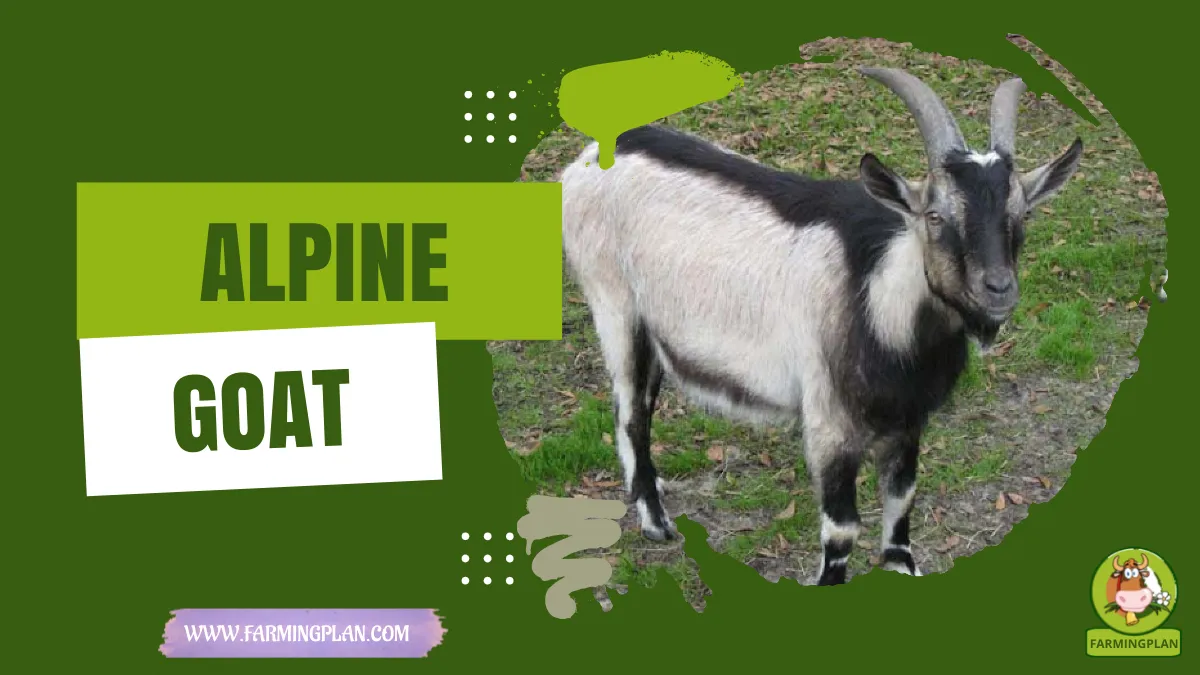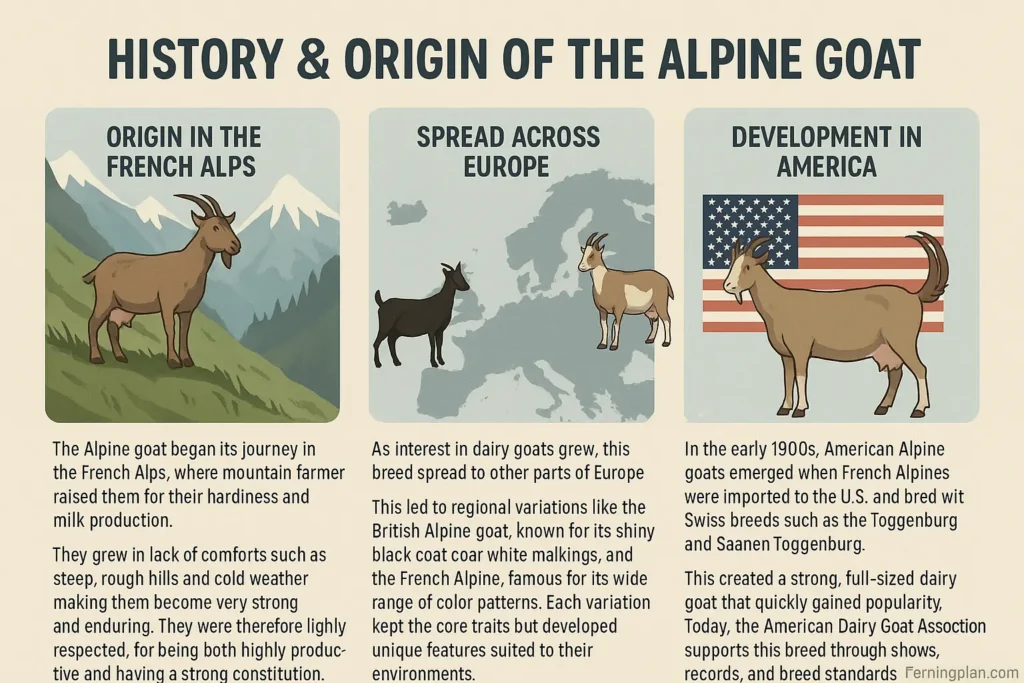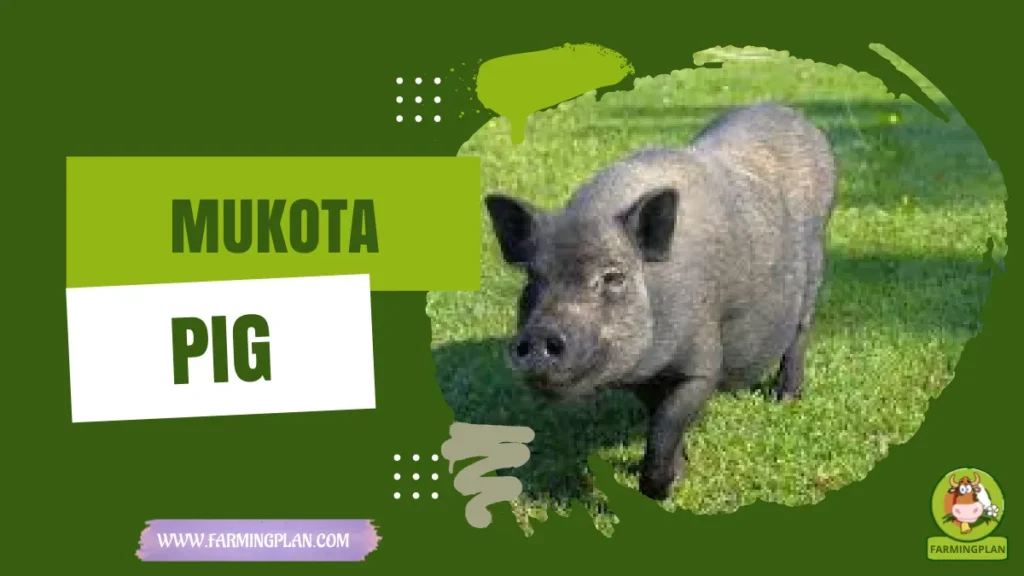The Alpine goat is a popular dairy goat breed known for its excellent milk production, friendly nature, and eye-catching color patterns. Originating from the French Alps, this full-sized goat is loved by farmers, homesteaders, and hobbyists alike. From the adaptable American Alpine goat to the striking British Alpine goat, this breed thrives in various climates and fits well into any farm or backyard. With distinct black and white markings, strong build, and high milk yield, Alpine goats are ideal for anyone looking to raise healthy, productive animals. In this guide, you’ll learn everything about Alpine goats—from their origin and care to feeding, health tips, and where to find Alpine goats for sale.

History & Origin of the Alpine Goat
The Alpine goat began its journey in the French Alps, where mountain farmers raised them for their hardiness and milk production.They grew in lack of comforts such as steep, rough hills and cold weather making them become very strong and enduring. They were therefore highly respected, for being both highly productive and having a strong constitution.

Spread Across Europe
As interest in dairy goats grew, this breed spread to other parts of Europe. This led to regional variations like the British Alpine goat, known for its shiny black coat and white markings, and the French Alpine, famous for its wide range of color patterns. Each variation kept the core traits but developed unique features suited to their environments.
Development in America
In the early 1900s, American Alpine goats emerged when French Alpines were imported to the U.S. and bred with Swiss breeds such as the Toggenburg and Saanen Toggenburg. This created a strong, full-sized dairy goat that quickly gained popularity. Today, the American Dairy Goat Association supports this breed through shows, records, and breed standards.
Read More: Top 10 Dairy Goat Breeds
A Global Dairy Goat Favorite
Thanks to their excellent milk production and unique markings, Alpine goats are now raised worldwide. From homesteads to commercial farms, this goat breed continues to be a top choice for those seeking a dependable and productive animal.
Characteristics of the Alpine Goat
This goat is a full-sized goat with a strong, sturdy frame. Males usually weigh around 170 pounds, while females weigh about 135 pounds. These goats have upright ears and a straight face, giving them an alert and elegant appearance. Their build makes them perfect for both dairy production and mountain terrain.
Wide Range of Color Patterns
Alpine goats come in many colors, unlike some breeds that are mostly white. You’ll find patterns like Chamoisée, Cou clair, and even Toggenburg patterned individuals. Their coats may include black stripes, white markings, grey hindquarters, or even a pale neck. These striking color combinations make them easy to recognize.

Distinctive Facial and Body Markings
One key trait of this dairy goat breed is its characteristic markings. Look for black leg markings, dorsal stripes, and bold facial stripes. Some goats have a white neck or black hindquarters, while others feature a broken pattern that makes them stand out. These visual types can vary, but they all follow a standard set by breeders.
Read More: Best Bionda dell’Adamello Goat
Variants Within the Breed
Different regions have created their own Alpine types. The American Alpine goat often shows more color variety, while the British Alpine goat tends to be mostly black with white accents. Each type still offers excellent production and strong dairy traits. These Alpine types remain consistent in quality, no matter the location.
Nature & Temperament of the Alpine Goat
This goat is known for its friendly, curious, and confident nature. These goats enjoy interacting with people and other animals, which makes them a great fit for farms, homesteads, and even as pets. Their alert expressions and energetic behavior often make them the center of attention in any herd.
Highly Social and Adaptable
Alpine goats are social animals that thrive in groups. They don’t like being alone, so it’s best to keep them with other goats or animals. Their ability to adapt to different climates and environments—from cold mountains to warm farms—makes them one of the most reliable domestic goats for various owners.
Smart and Easy to Train
This breed of goat is intelligent and can quickly learn routines, making daily care easier. They respond well to consistent handling and training, especially when raised in a calm and safe environment. Farmers often use them as pack goats because of their ability to follow directions and work in tough terrain.
Best for Experienced and New Owners
Whether you’re a first-time goat owner or an experienced breeder, Alpine goats are easy to manage. Their good behavior, paired with their strong work ethic and milk production, makes them ideal for both small hobby farms and large dairy operations.
Read More: Why Kiko Goats Are Perfect For Your Farm
Food & Diet for Alpine Goats
An Alpine goat needs a balanced diet to stay healthy and produce high-quality milk. Hay should make up most of their daily intake. Offer clean, dry hay—like alfalfa or grass hay—every day. Goats also enjoy browsing on shrubs and weeds, which adds natural variety to their diet.
Grains for Energy
You can add grains to support energy needs, especially for Alpine goat females producing milk. Feed small amounts of goat pellets or a grain mix with corn, oats, or barley. Be careful not to overfeed grains, as too much can upset their digestion.
Essential Minerals and Supplements
Provide a loose goat mineral mix with key nutrients like calcium, phosphorus, and selenium. Use a separate mineral feeder so they can eat what they need. Fresh, clean water should always be available, especially during hot weather or while milking.
Foods to Avoid
Never feed Alpine goats chocolate, onions, moldy feed, or plants like azaleas and rhododendrons. These can make them sick or even be fatal. Stay away from leftover human food and always check pasture areas for toxic plants.
“A healthy Alpine goat starts with the right hay, clean water, and a good mineral mix—keep it simple and consistent.”
Usage & Purpose of the Alpine Goat
One of the main reasons people raise Alpine goats is for their excellent milk production. Known for high butterfat content, Alpine goat milk is perfect for making cheese, yogurt, and even soap. Due to their reliable milk output the goats are favoured by dairy farmers with record producers capable of producing up to 2 gallons of milk daily.
Ideal for Small Farms and Homesteads
Alpine goats are perfect for homestead milk goats and small farms looking for an efficient dairy animal. Their size and temperament make them manageable even for beginners.Their dependence on pasture and restricted supplementation is in good accordance with their utility in dairy processes.
Use as Pack Goats
Other than dairy products, pack goats are commonly utilized by Alpine goats to carry loads. Alpine goats are well adapted for hiking, camping, and pack expeditions owing to their healthy nature and mild temperament. They are preferred by both adventurers and farmers in moving goods long distances, as their physical form is robust and adaptable.
Show Goats and Breeding
Alpine goats are a favorite at dairy goat shows due to their striking appearance and excellent breed standards. With their wide range of colors and markings, they often win top prizes at competitions. For breeders, Alpine goats provide valuable genetics for improving dairy herds.
Special Features of the Alpine Goat
The main value of the Alpine goat is its very efficient milk production. It is because of these goats ability to produce a lot of milk that they become indispensable in the dairy farming. The milk is rich in butterfat, making it ideal for creating a variety of dairy products, including cheese and yogurt.
Wide Range of Color Patterns
Alpine goats differ from others by a huge variety of colors and patterns on their coats. Goats can be very diverse with some for example white and others with some combination of black, gray, brown – marked by black necks, dorsal stripes or facial stripes. This variety gives each Alpine goat a unique, eye-catching look, which makes them stand out among other dairy breeds.
Hardy and Adaptable
Alpine goats are incredibly hardy, able to withstand different climates—from the cold, high-altitude regions of their native Alps to warmer, more temperate zones. Their adaptability to various environments makes them suitable for farming in many parts of the world. They are also relatively low-maintenance, which is another reason they are favored by beginner goat owners.
Strong Work Ethic
Known for their strong work ethic, Alpine goats are not just for milk production—they’re also used as pack goats. Their sturdy bodies, intelligence, and ability to follow directions make them perfect for carrying loads on hikes or farm tasks. This versatility sets them apart from many other dairy breeds.
Health Issues & Prevention for Alpine Goats
As in the case of other goats, Alpine goats can have special aggravation of the health. Parasites’ infestations are a common concern, and most of the time, it leads to weight loss and fatigue as well as milk output. Periodic administration of dewormers is an important way to prevent and treat parasite infestation. Foot rot is a danger to Alpine goats, and particularly when their environment remains wet for long periods. Unity in handling and ensuring the hooves remain trimmed and dry is the remedy to this predicament.
Respiratory Issues
Respiratory infections can also affect Alpine goats, particularly during colder months. Cough, nasal discharge, and laboured breathing are all signs of respiratory distress. Avoid respiratory problems by maintaining proper ventilation, and keeping your animals in different accommodations. Clean and well dried environment assists in reducing the risks relating to respiratory illnesses.
Prevention Through Regular Checkups
Routine veterinary care is crucial to maintaining the health of your Alpine goats. Regular checkups will help spot potential issues early on. Vaccinations against diseases like CL (Caseous Lymphadenitis) and CAE (Caprine Arthritis Encephalitis) can keep your goats protected. Don’t forget to monitor their dental health, as poor teeth can lead to feeding difficulties.
Proper Nutrition for Disease Prevention
A balanced diet is essential for maintaining strong immunity in your Alpine goats. Make sure they have access to fresh water, quality hay, and the right mineral supplements. Proper nutrition helps strengthen their immune system, making them more resistant to diseases. If your goats are stressed or malnourished, they’ll be more vulnerable to infections.
Step-by-Step Farming Guide for Alpine Goats
The Step-by-Step Farming Guide for Alpine Goats focuses on creating a safe, comfortable environment for these hardy animals. Begin by setting up proper fencing and shelter to protect them from harsh weather. Provide daily care through feeding high-quality hay, fresh water, and routine health checks, such as hoof trimming and grooming. Keep an eye on your goats for sick deaths or parasites and keep a sanitized environment for them. Regular and hygienic milking methods in dairy farms play a great role in good production. A strict time table follows to keep your Alpine goats healthy and that you’d be able to collect milk regularly in the course of the years.
Step 1- Setting Up the Right Space
Before your goats come to your home, it is very important to arrange their housing environment. Ensure your goats are provided with a spacious dry and sanitary condition. For groups of less goats, it is advisable to get 200 – 300 square feet per goat. At least 4-5 feet tall fence will help prevent goats from getting out. It is important to keep in mind that goats can jump very high and scramble up to great altitudes.
Step 2- Providing Shelter and Protection
Alpine goats need protection from extremes of temperature, regardless of whether it’s blistering hot or frigid cold. An open sided barn has good ventilation and it is the best solution. The shelter should be draft free and should be filled with dry materials such as straw and hay to make the goats comfortable. Shelter the sun by creating a shaded region during the warmer days of the year.
Step 3- Daily Care Routine
Alpine goats require daily care to stay healthy. Start by feeding them high-quality hay, clean water, and any grain or supplements needed for their milk production. Proper hoof examination and timely hoof trimming are essential to avoid the progression of the hoof rot. Regular weekly shelter cleaning as well as the verification that the fencing is sturdy can help repel diseases and protect your goats.
Step 4- Grooming and Health Maintenance
Regular grooming helps keep Alpine goats clean and comfortable. Brush their coats to remove dirt and loose hair, and check for signs of parasites or skin issues. Keep a close eye on their teeth and hooves. Trim hooves every 4-6 weeks to prevent foot problems, and monitor their health for any changes in behavior or appetite.
Step 5- Milking and Lactation
Milking your Alpine goat is a daily task that requires consistency. Ensure the goat is calm and comfortable, and clean their udder before milking. Use proper equipment, and always ensure the milk is stored in sanitary conditions to prevent contamination. During lactation, provide extra nutrition to support milk production, and monitor for any signs of mastitis or other infections.
Expert Tips & Best Practices for Alpine Goats
One of the best ways to keep your Alpine goats healthy and happy is by sticking to a consistent daily routine. Goats thrive on regular feeding and milking schedules. Consistency helps reduce stress and ensures that they remain calm, especially when it comes to milking or health checks. Try to feed and milk at the same time each day.
Provide Plenty of Space for Browsing
Alpine goats, renowned for toughness & adaptability, fare best if left to wander about and pick their food. Let them feed in a pasture with natural feeding on grass, weeds and shrubs. This exposure to diversified forages also boosts nutritional diversity, and helps promote their overall well-being. If your space is limited then ensure your goats get the access to appropriate forages and grains for a balanced diet.
Invest in Quality Equipment
To ensure efficient care, invest in high-quality equipment. From goat milking machines to mineral feeders and hoof trimming tools, the right gear will save you time and ensure the safety of your Alpine goats. Clean, sterilized milking equipment is crucial for maintaining milk quality and avoiding bacterial infections.
Regular Vet Checkups and Vaccinations
Good animal health needs constant veterinary inspection despite high standards of care. With vaccinating your Alpine goats against such diseases as CAE and CL, you help them gain a stronger immunity against serious illnesses. A good relationship with a local vet who understands goats will ensure that you can quickly address any health issues before they become serious.
Keep Their Environment Clean and Dry
A clean environment is key to preventing many common health issues in Alpine goats, such as respiratory infections and hoof rot. Make sure their shelter is dry, well-ventilated, and free of feces. Regularly clean bedding and replace it with fresh straw or hay to avoid bacterial buildup.
FAQ
What is the Alpine goat breed known for?
Alpine goats are famous for their production qualities of milk. Having good dairy quality, this breed can survive in various climates.
What should I feed my Alpine goat?
Alpine goats primarily require high-quality hay (90-100% of their diet), supplemented with grains and forages in moderation. Providing a balanced diet ensures their health and optimal milk production.
How can I prevent health issues in Alpine goats?
Regular vaccinations, such as the CD&T vaccine, are essential to protect Alpine goats from diseases like enterotoxaemia. Additionally, maintaining a clean environment and proper nutrition contributes to their overall health.
What are common health problems in Alpine goats?
Alpine goats may experience issues like enterotoxaemia and pregnancy toxemia. Preventative measures include appropriate vaccinations and dietary adjustments, especially during late pregnancy.
How can I care for my Alpine goat effectively?
Providing a clean, dry shelter, regular hoof trimming, and a consistent feeding schedule are crucial for Alpine goat care. Regular health check-ups and maintaining a stress-free environment also contribute to their well-being.
Conclusion
Alpine goats are a versatile and hardy breed, prized for their high milk production and adaptability to various climates. With proper care, including a balanced diet, regular health check-ups, and a clean living environment, they can thrive and provide valuable dairy products. Whether you’re a seasoned farmer or a beginner, understanding their needs ensures a healthy and productive herd


